Research and Application of Non-Steady-State CO2 Huff-n-Puff Oil Recovery Technology in High-Water-Cut and Low-Permeability Reservoirs
Abstract
:1. Introduction
2. Experimental Methods
2.1. Crude Oil Sample
2.2. Composition of Formation Water
2.3. Methods to Characterize Crude Oil Properties
- (1)
- Clean, dry, and vacuumize the whole system, including the PVT kettle, pipeline, and sample barrel. Inject a 40 mL crude oil sample into the visualization chamber.
- (2)
- At 70 °C, use CO2 with purity of 99.99% to pressurize to a predetermined pressure. Stabilize until the system pressure reaches equilibrium. Use an oil bath to regulate the experimental temperature.
- (3)
- Measure the height and pressure of the sample. After stirring, keep the pressure stable for 40 min to allow the system to reach thermodynamic equilibrium. At the same time, measure the oil level and volume.
- (4)
- Remove the oil from the kettle and place it into a small cylinder that has been evacuated and weighed. Calculate the mass of CO2 dissolved in the oil through the weight difference method.
- (5)
- Use a high-temperature and high-pressure viscometer to measure the viscosity of the crude oil at different solubilities.
- (1)
- Six pressure points were set for the experiment, which included the MMP, at least two pressure values greater than the MMP, and two pressure values less than the MMP. The original formation pressure of the Mutou Oilfield was used as the reference to set the injection pressure, and six injection pressure points were selected for the slim tube experiment: 15 MPa, 20 MPa, 25 MPa, 30 MPa, 35 MPa, and 40 MPa.
- (2)
- The temperature and pressure of the equipment were adjusted to specified values and it was run for a period of time to balance the formation system. A back pressure valve was used to control the injection pressure to ensure that the set pressure was reached.
- (3)
- Then, CO2 was injected for displacement. The gas injection rate was set to be 0.15 mL/min, and the volume of the produced crude oil was measured during displacement.
- (4)
- When injecting 1.2 PV of CO2, the recovery rate remained essentially constant under different injection pressures [48]. Therefore, the recovery rate after injecting 1.2 PV of CO2 represented the overall recovery rate.
2.4. Method for High-Temperature and High-Pressure Microfluidic Experiment
- (1)
- The high-temperature and high-pressure microscopic visualization displacement process is shown in Figure 2. Vacuumize it, saturate it with water and then oil, and age it.
- (2)
- After water flooding to the high-water-cut stage, close the outlet valve. Inject CO2 at a steady constant injection rate of 0.003 mL/min for 0.3 PV or NSS stepwise increasing injection rates of 0.001 mL/min, 0.003 mL/min, and 0.005 mL/min for 0.1 PV each. Then, close the inlet valve and soak for 24 h. Open the inlet valve and record the images during the oil production process.
- (3)
- Use the software IMAGEJ v1.48 to batch-process the captured images to derive the quantified data and processed images at each moment; analyze the remaining oil and CO2 swept area, with a standard deviation of ±0.05%.
2.5. Field Pilot Test Method
3. Results and Discussion
3.1. CO2–Crude Oil Gas Injection Swelling Experiment
3.2. Minimum Miscibility Pressure Testing Experiment
3.3. High-Temperature and High-Pressure Microfluidic Experiment
3.3.1. Results of NSS CO2 Huff-n-Puff Microscopic Displacement Experiment
3.3.2. Changes in Solution Gas–Water Ratio during Flowback Process
3.4. Field Pilot Test Results of NSS CO2 Huff-n-Puff
3.5. Evaluation of Oil and Gas Properties during NSS CO2 Huff-n-Puff
4. Conclusions
Author Contributions
Funding
Data Availability Statement
Conflicts of Interest
References
- Zhou, X.; Yuan, Q.; Zhang, Y.; Wang, H.; Zeng, F.; Zhang, L. Performance Evaluation of CO2 Flooding Process in Tight Oil Reservoir via Experimental and Numerical Simulation Studies. Fuel 2019, 236, 730–746. [Google Scholar] [CrossRef]
- Yongle, H.; Mingqiang, H.; Guoli, C.; Ruiyan, S.; Shi, L. Technologies and Practice of CO2 Flooding and Sequestration in China. Pet. Explor. Dev. 2019, 46, 753–766. [Google Scholar] [CrossRef]
- Song, Z.; Li, Y.; Song, Y.; Bai, B.; Hou, J.; Song, K.; Jiang, A.; Su, S. A Critical Review of CO2 Enhanced Oil Recovery in Tight Oil Reservoirs of North America and China. In Proceedings of the SPE Asia Pacific Oil and Gas Conference and Exhibition, Virtual, 17–19 November 2020. [Google Scholar]
- Ren, B.; Zhang, L.; Huang, H.; Ren, S.; Chen, G.; Zhang, H. Performance Evaluation and Mechanisms Study of Near-Miscible CO2 Flooding in a Tight Oil Reservoir of Jilin Oilfield China. J. Nat. Gas Sci. Eng. 2015, 27, 1796–1805. [Google Scholar] [CrossRef]
- Pu, W.; Wei, B.; Jin, F.; Li, Y.; Jia, H.; Liu, P.; Tang, Z. Experimental Investigation of CO2 Huff-n-Puff Process for Enhancing Oil Recovery in Tight Reservoirs. Chem. Eng. Res. Des. 2016, 111, 269–276. [Google Scholar] [CrossRef]
- Lv, G.; Li, Q.; Wang, S.; Li, X. Key Techniques of Reservoir Engineering and Injection–Production Process for CO2 Flooding in China’s SINOPEC Shengli Oilfield. J. CO2 Util. 2015, 11, 31–40. [Google Scholar] [CrossRef]
- Qin, J.; Han, H.; Liu, X. Application and Enlightenment of Carbon Dioxide Flooding in the United States of America. Pet. Explor. Dev. 2015, 42, 232–240. [Google Scholar] [CrossRef]
- Hill, B.; Hovorka, S.; Melzer, S. Geologic Carbon Storage through Enhanced Oil Recovery. Energy Procedia 2013, 37, 6808–6830. [Google Scholar] [CrossRef]
- Ettehadtavakkol, A.; Lake, L.W.; Bryant, S.L. CO2-EOR and Storage Design Optimization. Int. J. Greenh. Gas Control 2014, 25, 79–92. [Google Scholar] [CrossRef]
- Du, D.; Pu, W.; Jin, F.; Liu, R. Experimental Study on EOR by CO2 Huff-n-Puff and CO2 Flooding in Tight Conglomerate Reservoirs with Pore Scale. Chem. Eng. Res. Des. 2020, 156, 425–432. [Google Scholar] [CrossRef]
- Dai, Z.; Middleton, R.; Viswanathan, H.; Fessenden-Rahn, J.; Bauman, J.; Pawar, R.; Lee, S.-Y.; McPherson, B. An Integrated Framework for Optimizing CO2 Sequestration and Enhanced Oil Recovery. Environ. Sci. Technol. Lett. 2014, 1, 49–54. [Google Scholar] [CrossRef]
- Bachu, S. Identification of Oil Reservoirs Suitable for CO2-EOR and CO2 Storage (CCUS) Using Reserves Databases, with Application to Alberta, Canada. Int. J. Greenh. Gas Control 2016, 44, 152–165. [Google Scholar] [CrossRef]
- Azzolina, N.A.; Nakles, D.V.; Gorecki, C.D.; Peck, W.D.; Ayash, S.C.; Melzer, L.S.; Chatterjee, S. CO2 Storage Associated with CO2 Enhanced Oil Recovery: A Statistical Analysis of Historical Operations. Int. J. Greenh. Gas Control 2015, 37, 384–397. [Google Scholar] [CrossRef]
- Ampomah, W.; Balch, R.; Cather, M.; Will, R.; Gunda, D.; Dai, Z.; Soltanian, M. Optimum Design of CO2 Storage and Oil Recovery under Geological Uncertainty. Appl. Energy 2017, 195, 80–92. [Google Scholar] [CrossRef]
- Liu, Z.; Gao, M.; Zhang, X.; Liang, Y.; Guo, Y.; Liu, W.; Bao, J. CCUS and CO2 Injection Field Application in Abroad and China: Status and Progress. Geoenergy Sci. Eng. 2023, 229, 212011. [Google Scholar] [CrossRef]
- Hill, L.B.; Li, X.; Wei, N. CO2-EOR in China: A Comparative Review. Int. J. Greenh. Gas Control 2020, 103, 103173. [Google Scholar] [CrossRef]
- Lan, Y.; Yang, Z.; Wang, P.; Yan, Y.; Zhang, L.; Ran, J. A Review of Microscopic Seepage Mechanism for Shale Gas Extracted by Supercritical CO2 Flooding. Fuel 2019, 238, 412–424. [Google Scholar] [CrossRef]
- Xia, X.; Deng, Q.; Sang, P.; Tan, L.; Yan, L.; Bao, J.; Li, W. Low-Carbon Oil Exploitation: Carbon Dioxide Flooding Technology. Front. Earth Sci. 2023, 10, 1035771. [Google Scholar] [CrossRef]
- Chai, X.; Tian, L.; Zhang, M.; Shao, H.; Wang, J.; Zhang, K. Production Characteristics, Evaluation, and Prediction of CO2 Water-Alternating-Gas Flooding in Tight Oil Reservoir. J. Energy Resour. Technol. 2022, 144, 033006. [Google Scholar] [CrossRef]
- Khoshsima, A.; Sedighi, M.; Mohammadi, M. Chapter 8—Enhanced Oil Recovery by Water Alternating Gas Injection. In Gas Injection Methods; Li, Z., Husein, M.M., Hemmati-Sarapardeh, A., Eds.; Enhanced Oil Recovery Series; Gulf Professional Publishing: Houston, TX, USA, 2023; pp. 295–316. ISBN 978-0-12-822302-4. [Google Scholar]
- Iding, M.; Ringrose, P. Evaluating the Impact of Fractures on the Performance of the in Salah CO2 Storage Site. Int. J. Greenh. Gas Control 2010, 4, 242–248. [Google Scholar] [CrossRef]
- Fu, P.; Settgast, R.R.; Hao, Y.; Morris, J.P.; Ryerson, F.J. The Influence of Hydraulic Fracturing on Carbon Storage Performance. J. Geophys. Res. Solid Earth 2017, 122, 9931–9949. [Google Scholar] [CrossRef]
- Fitts, J.P.; Peters, C.A. Caprock Fracture Dissolution and CO2 Leakage. Rev. Mineral. Geochem. 2013, 77, 459–479. [Google Scholar] [CrossRef]
- Zeng, J.; Cheng, S.; Kong, X.; Guo, K.; Wang, H. Non-Darcy Flow in Oil Accumulation (Oil Displacing Water) and Relative Permeability and Oil Saturation Characteristics of Low-Permeability Sandstones. Pet. Sci. 2010, 7, 20–30. [Google Scholar] [CrossRef]
- Yao, Y.; Ge, J. Characteristics of Non-Darcy Flow in Low-Permeability Reservoirs. Pet. Sci. 2011, 8, 55–62. [Google Scholar] [CrossRef]
- Liu, C. Numerical Simulation of Ultra-Low Permeability Reservoirs: Progress and Challenges. Front. Energy Res. 2022, 10, 895135. [Google Scholar] [CrossRef]
- Li, H.; Li, Y.; Chen, S.; Guo, J.; Wang, K.; Luo, H. Effects of Chemical Additives on Dynamic Capillary Pressure during Waterflooding in Low Permeability Reservoirs. Energy Fuels 2016, 30, 7082–7093. [Google Scholar] [CrossRef]
- Liu, Q.; Wu, K.; Li, X.; Tu, B.; Zhao, W.; He, M.; Zhang, Q.; Xie, Y. Effect of Displacement Pressure on Oil–Water Relative Permeability for Extra-Low-Permeability Reservoirs. ACS Omega 2021, 6, 2749–2758. [Google Scholar] [CrossRef] [PubMed]
- Kang, W.-L.; Zhou, B.-B.; Issakhov, M.; Gabdullin, M. Advances in Enhanced Oil Recovery Technologies for Low Permeability Reservoirs. Pet. Sci. 2022, 19, 1622–1640. [Google Scholar] [CrossRef]
- Zhang, H.; Yan, J.; Lu, Y.; Shu, Y.; Zhao, S. Experimental Study of Low-Damage Drilling Fluid to Minimize Waterblocking of Low-Permeability Gas Reservoirs. Pet. Sci. 2009, 6, 271–276. [Google Scholar] [CrossRef]
- Al-Shargabi, M.; Davoodi, S.; Wood, D.A.; Rukavishnikov, V.S.; Minaev, K.M. Minaev Carbon Dioxide Applications for Enhanced Oil Recovery Assisted by Nanoparticles: Recent Developments. ACS Omega 2022, 7, 9984–9994. [Google Scholar] [CrossRef]
- Sayegh, S.G.; Maini, B.B. Laboratory Evaluation of the CO2 Huff-N-Puff Process for Heavy Oil Reservoirs. J. Can. Pet. Technol. 1984, 23, PETSOC-84-03-02. [Google Scholar] [CrossRef]
- Chunsheng, P.; Shaofei, K.; Jingyang, P.; Xiaoyu, G.; Zhendong, G.; Yongdong, W.; Kai, W. Progress and Development Trend of Water Huff-n-Puff Technology for Horizontal Wells in Tight Oil Reservoirs in China. Acta Pet. Sin. 2023, 44, 188. [Google Scholar]
- Sambo, C.; Liu, N.; Shaibu, R.; Ahmed, A.A.; Hashish, R.G. A Technical Review of CO2 for Enhanced Oil Recovery in Unconventional Oil Reservoirs. Geoenergy Sci. Eng. 2023, 221, 111185. [Google Scholar] [CrossRef]
- Tan, Y.; Li, Q.; Xu, L.; Ghaffar, A.; Zhou, X.; Li, P. A Critical Review of Carbon Dioxide Enhanced Oil Recovery in Carbonate Reservoirs. Fuel 2022, 328, 125256. [Google Scholar] [CrossRef]
- Wan, Y.; Jia, C.; Lv, W.; Jia, N.; Jiang, L.; Wang, Y. Recovery Mechanisms and Formation Influencing Factors of Miscible CO2 Huff-n-Puff Processes in Shale Oil Reservoirs: A Systematic Review. Adv. Geo-Energy Res. 2024, 11, 88–102. [Google Scholar] [CrossRef]
- Wu, Z.; Sun, Z.; Shu, K.; Jiang, S.; Gou, Q.; Chen, Z. Mechanism of Shale Oil Displacement by CO2 in Nanopores: A Molecular Dynamics Simulation Study. Adv. Geo-Energy Res. 2024, 11, 141–151. [Google Scholar] [CrossRef]
- Zhou, X.; Yuan, Q.; Peng, X.; Zeng, F.; Zhang, L. A Critical Review of the CO2 Huff ‘n’ Puff Process for Enhanced Heavy Oil Recovery. Fuel 2018, 215, 813–824. [Google Scholar] [CrossRef]
- Dogah, B.; Atashbari, V.; Ahmadi, M.; Sheets, B. Enhanced Oil Recovery Using CO2 in Alaska. Geosciences 2021, 11, 98. [Google Scholar] [CrossRef]
- Zhang, X.; Wei, B.; You, J.; Liu, J.; Wang, D.; Lu, J.; Tong, J. Characterizing Pore-Level Oil Mobilization Processes in Unconventional Reservoirs Assisted by State-of-the-Art Nuclear Magnetic Resonance Technique. Energy 2021, 236, 121549. [Google Scholar] [CrossRef]
- Dyer, S.B.; Huang, S.S.; Ali, S.M.F.; Jha, K.N.N. Phase Behaviour And Scaled Model Studies of Prototype Saskatchewan Heavy Oils With Carbon Dioxide. J. Can. Pet. Technol. 1994, 33, PETSOC-94-08-05. [Google Scholar] [CrossRef]
- Zhang, Y.; Yu, W.; Li, Z.; Sepehrnoori, K. Simulation Study of Factors Affecting CO2 Huff-n-Puff Process in Tight Oil Reservoirs. J. Pet. Sci. Eng. 2018, 163, 264–269. [Google Scholar] [CrossRef]
- Tian, C.; Pang, Z.; Liu, D.; Wang, X.; Hong, Q.; Chen, J.; Zhang, Y.; Wang, H. Micro-Action Mechanism and Macro-Prediction Analysis in the Process of CO2 Huff-n-Puff in Ultra-Heavy Oil Reservoirs. J. Pet. Sci. Eng. 2022, 211, 110171. [Google Scholar] [CrossRef]
- Tang, Y.; Tang, J.; Liu, Q.; Wang, Y.; Zheng, Z.; Yuan, Y.; He, Y. Review on Phase Behavior in Tight Porous Media and Microscopic Flow Mechanism of CO2 Huff-n-Puff in Tight Oil Reservoirs. Geofluids 2020, 2020, 8824743. [Google Scholar] [CrossRef]
- Tang, W.-Y.; Sheng, J.J.; Jiang, T.-X. Further Discussion of CO2 Huff-n-Puff Mechanisms in Tight Oil Reservoirs Based on NMR Monitored Fluids Spatial Distributions. Pet. Sci. 2023, 20, 350–361. [Google Scholar] [CrossRef]
- Li, Q.; Wang, Y.; Owusu, A.B. A Modified Ester-Branched Thickener for Rheology and Wettability during CO2 Fracturing for Improved Fracturing Property. Environ. Sci. Pollut. Res. 2019, 26, 20787–20797. [Google Scholar] [CrossRef] [PubMed]
- Li, Q.; Liu, J.; Wang, S.; Guo, Y.; Han, X.; Li, Q.; Cheng, Y.; Dong, Z.; Li, X.; Zhang, X. Numerical Insights into Factors Affecting Collapse Behavior of Horizontal Wellbore in Clayey Silt Hydrate-Bearing Sediments and the Accompanying Control Strategy. Ocean Eng. 2024, 297, 117029. [Google Scholar] [CrossRef]
- Zhang, K.; Gu, Y. Two Different Technical Criteria for Determining the Minimum Miscibility Pressures (MMPs) from the Slim-Tube and Coreflood Tests. Fuel 2015, 161, 146–156. [Google Scholar] [CrossRef]
- Abedini, A.; Torabi, F. Parametric Study of the Cyclic CO2 Injection Process in Light Oil Systems. Ind. Eng. Chem. Res. 2013, 52, 15211–15223. [Google Scholar] [CrossRef]
- Abedini, A.; Torabi, F. Oil Recovery Performance of Immiscible and Miscible CO2 Huff-and-Puff Processes. Energy Fuels 2014, 28, 774–784. [Google Scholar] [CrossRef]
- Welker, J.R. Physical Properties of Carbonated Oils. J. Pet. Technol. 1963, 15, 873–876. [Google Scholar] [CrossRef]
- Mahdaviara, M.; Nait Amar, M.; Hemmati-Sarapardeh, A.; Dai, Z.; Zhang, C.; Xiao, T.; Zhang, X. Toward Smart Schemes for Modeling CO2 Solubility in Crude Oil: Application to Carbon Dioxide Enhanced Oil Recovery. Fuel 2021, 285, 119147. [Google Scholar] [CrossRef]
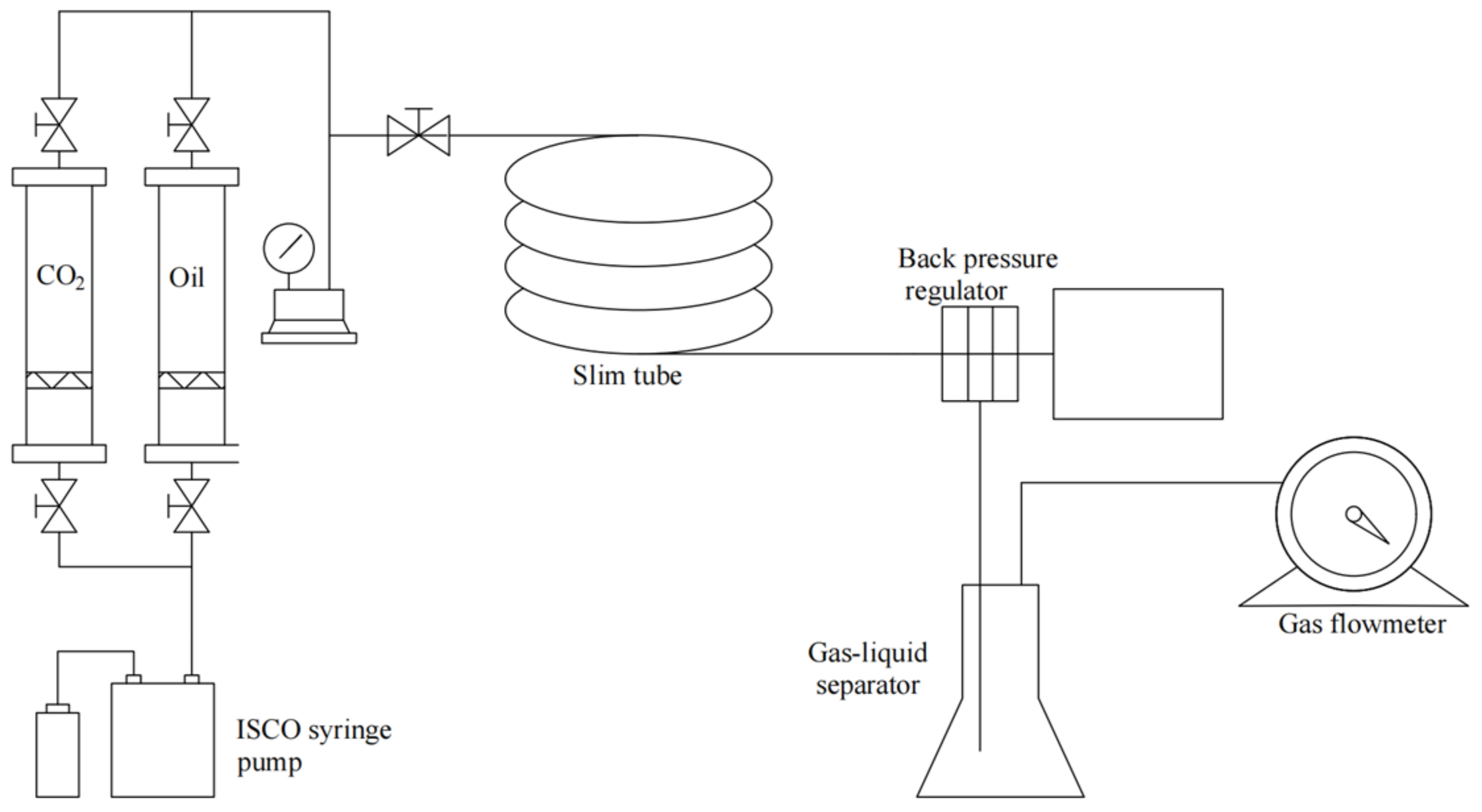
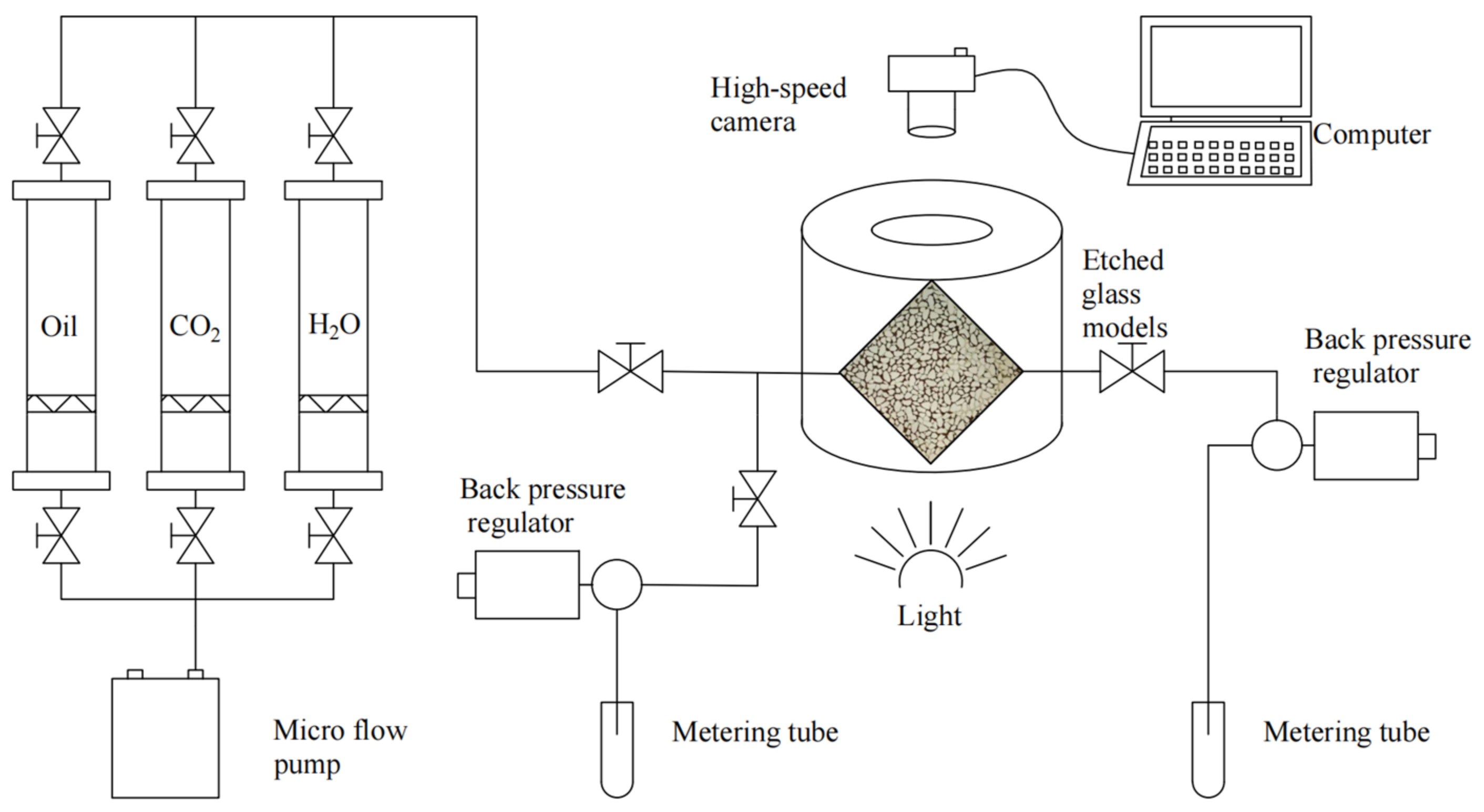
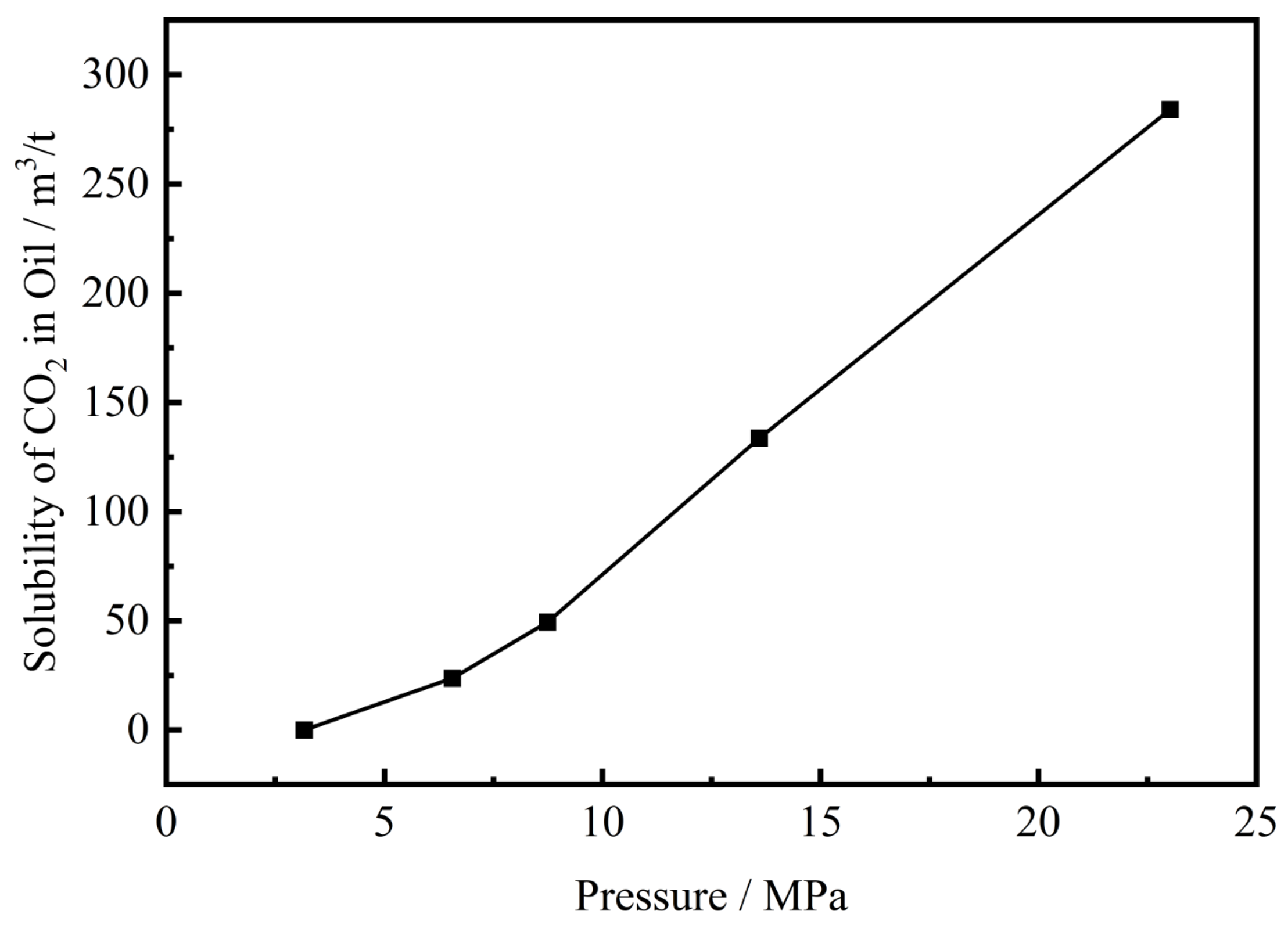
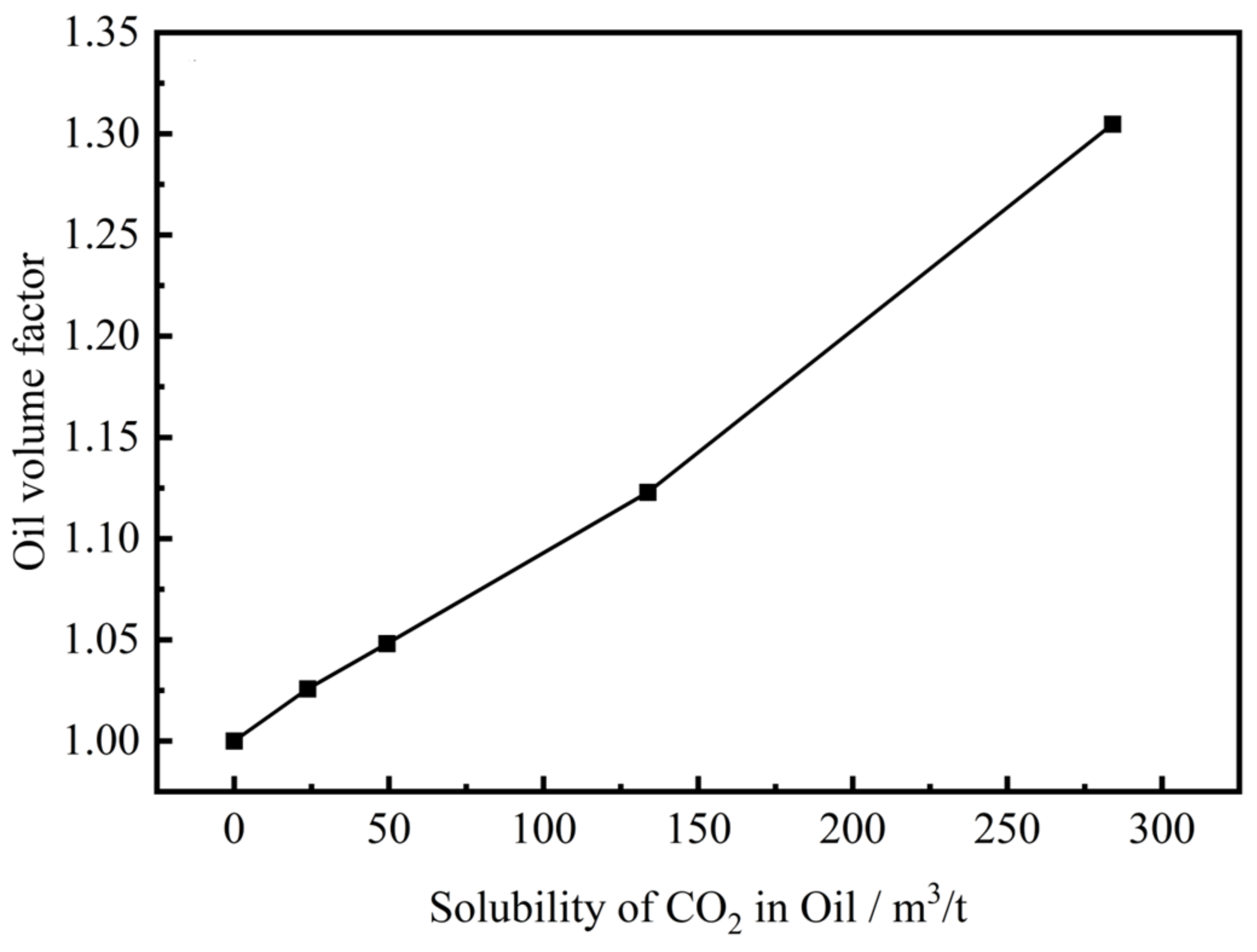
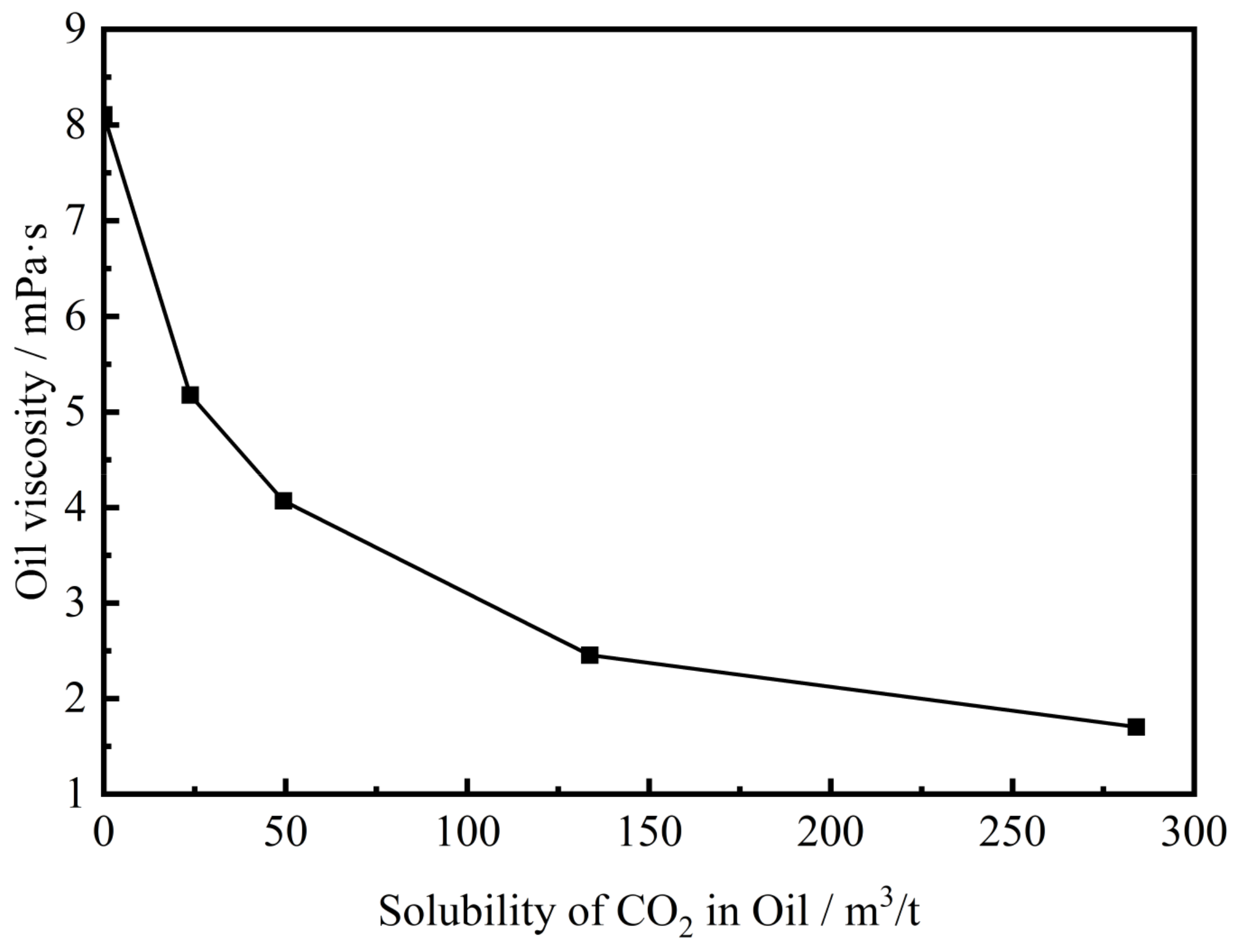

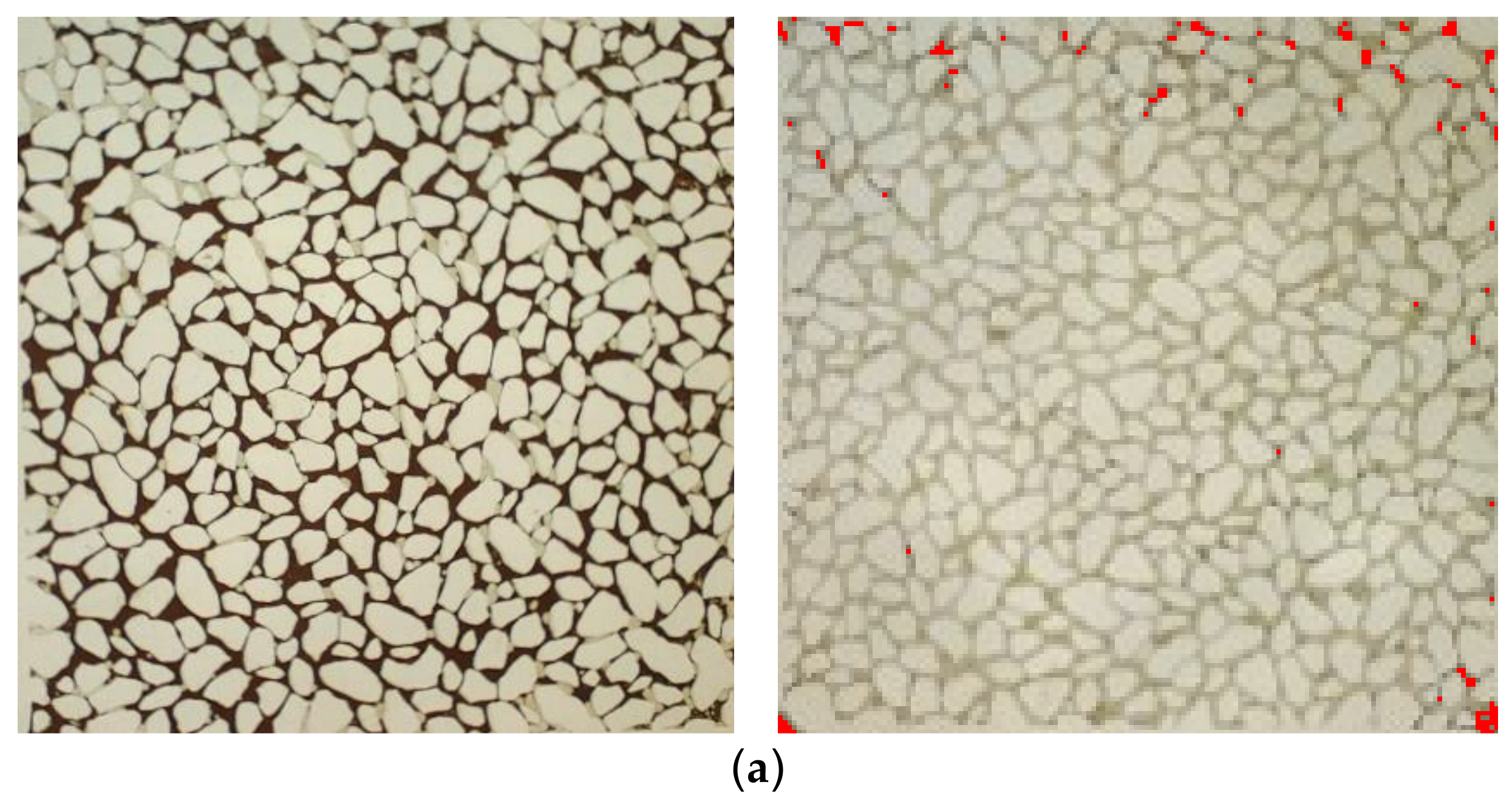
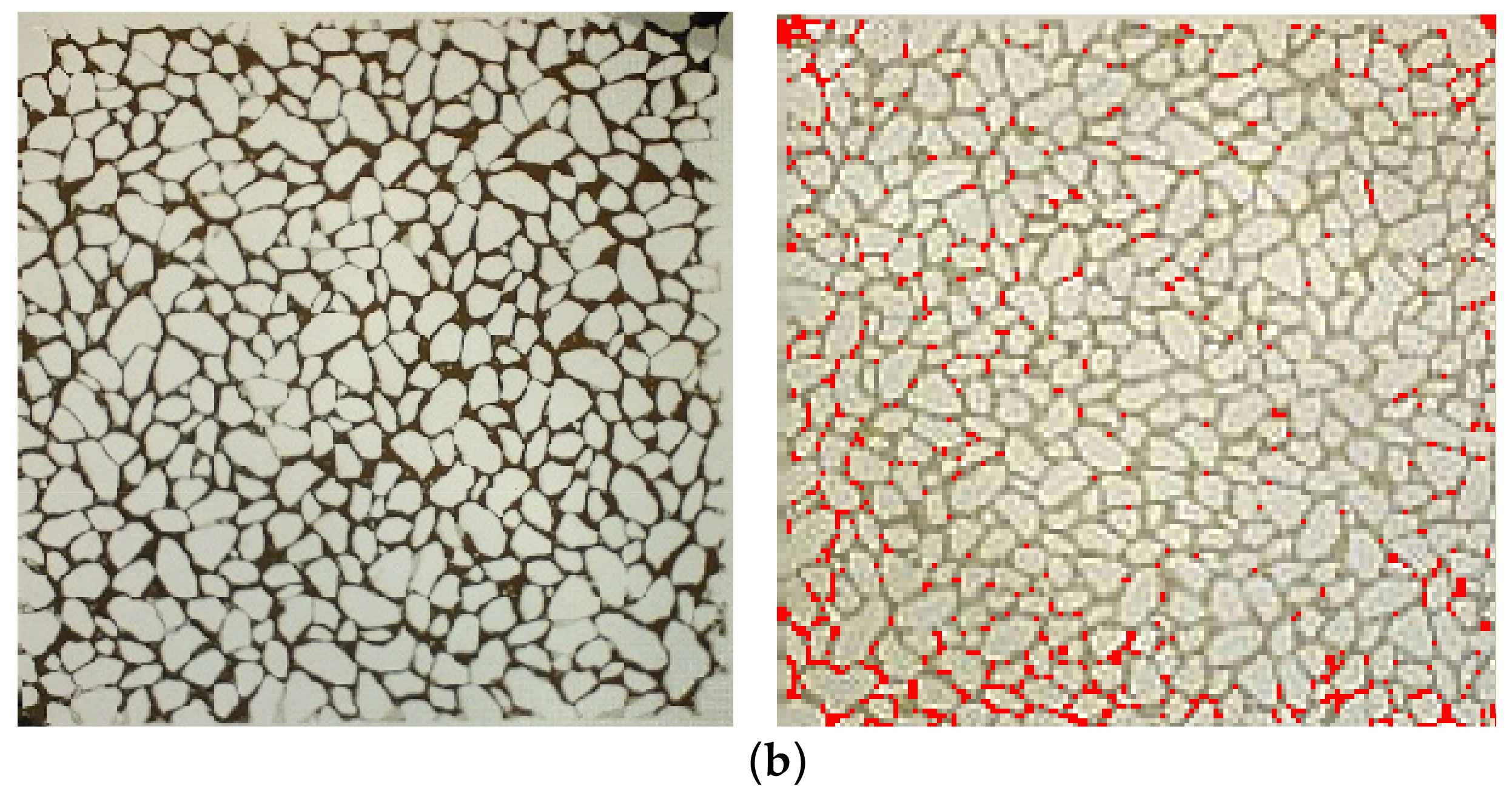
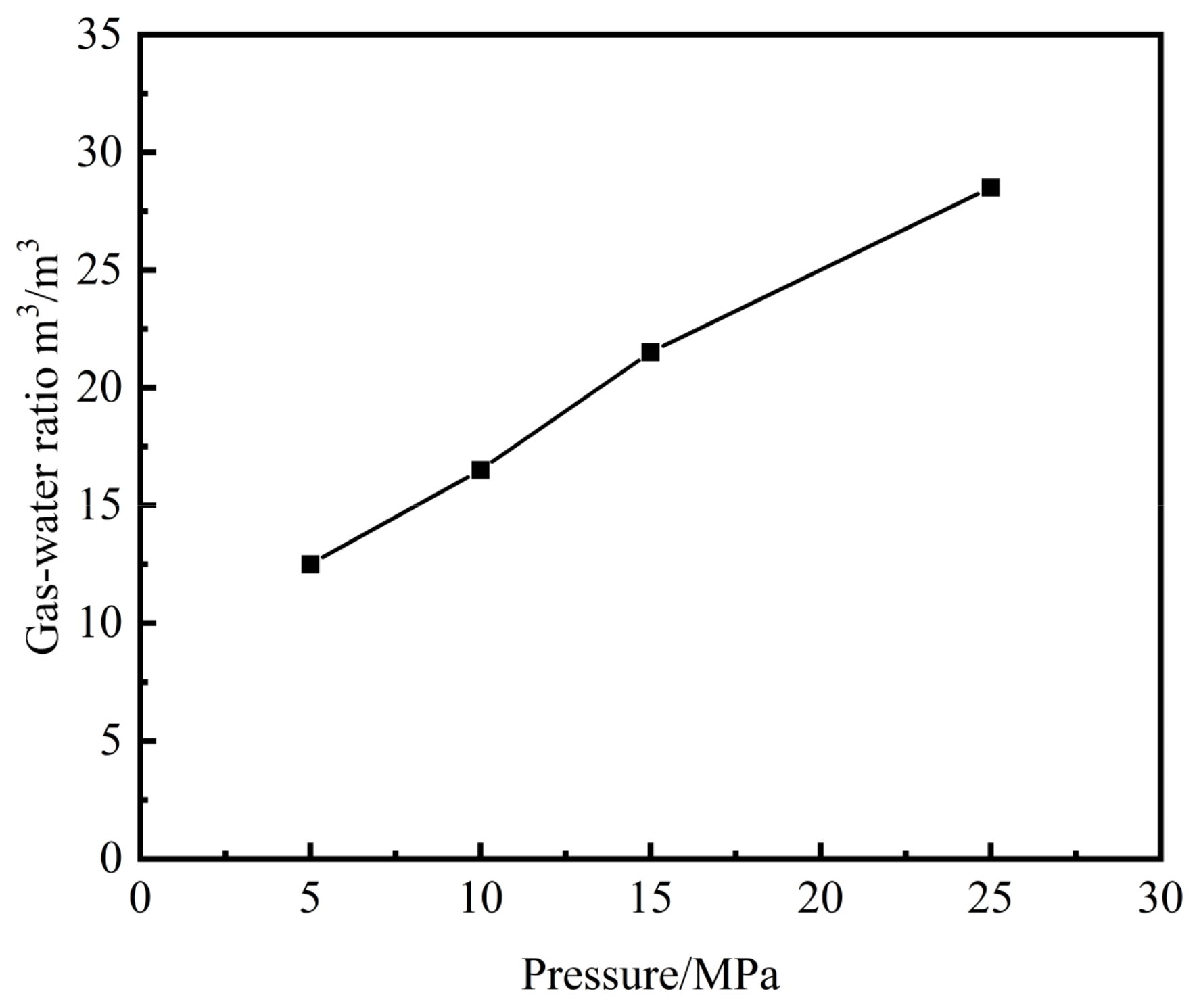
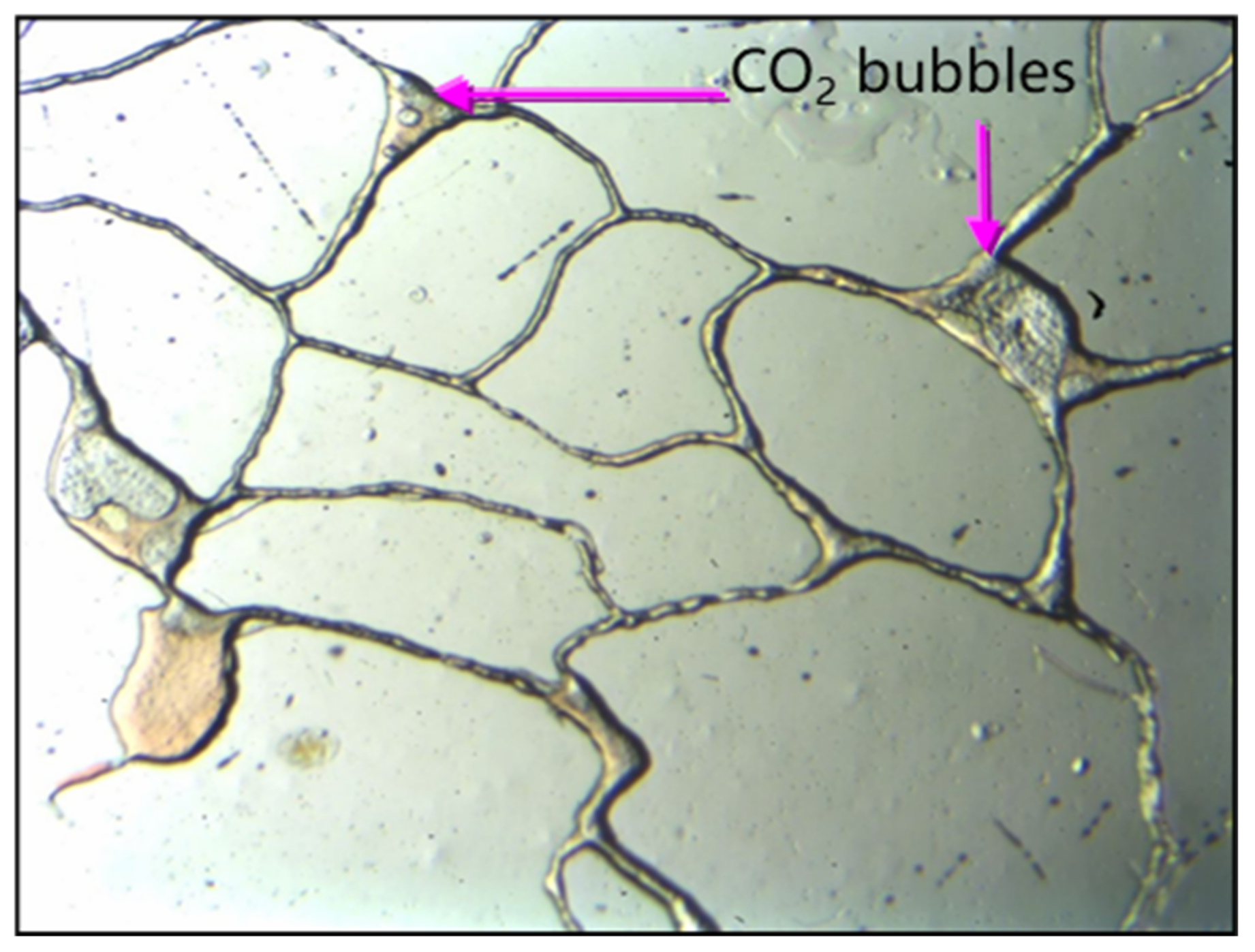
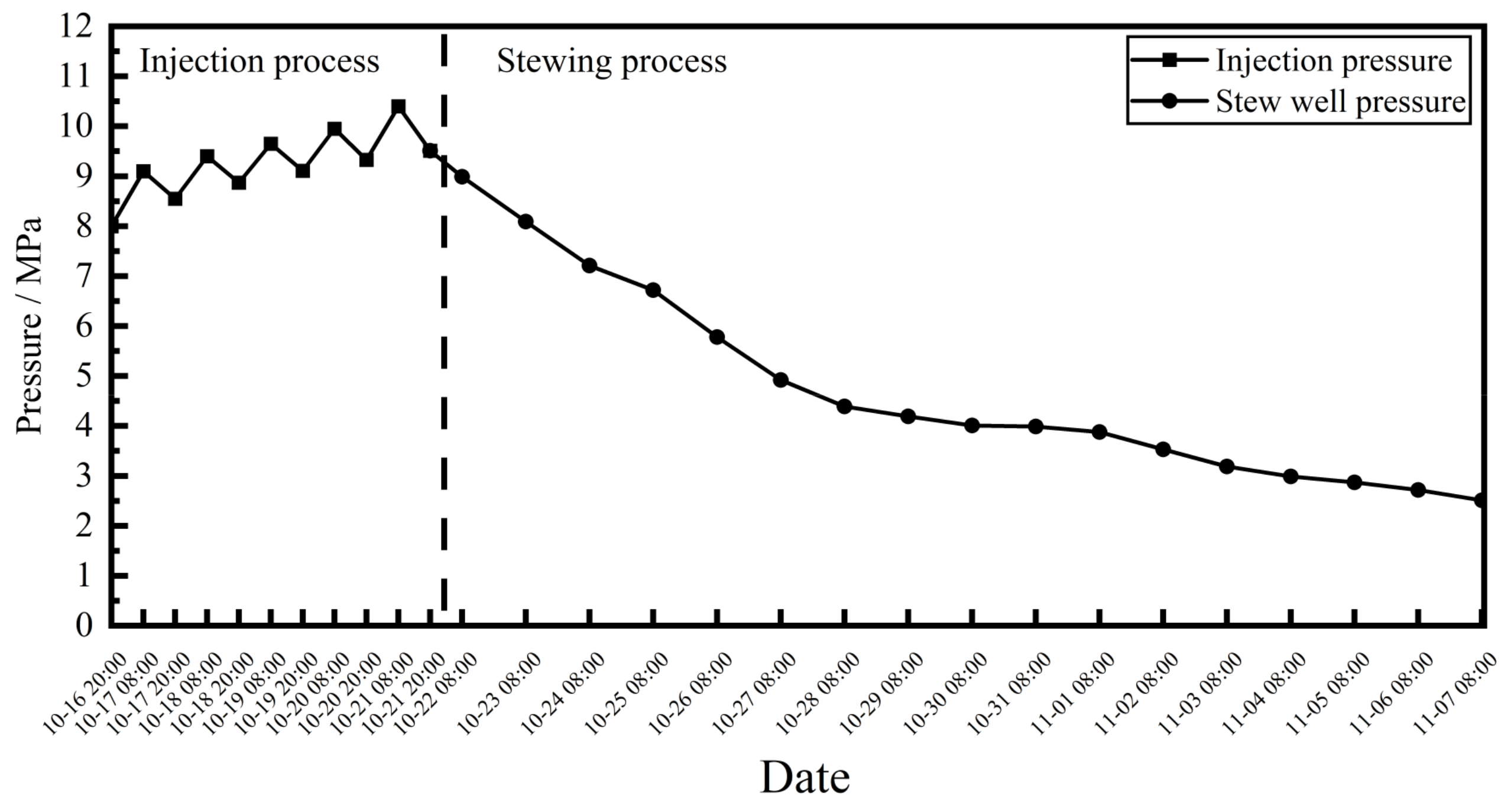



| Type | Development Problems | References |
|---|---|---|
| Reservoir properties | Low-permeability reservoirs have small pore throats and poor connectivity and exhibit non-Darcy seepage patterns. | [24,25,26] |
| The capillary force of low-permeability reservoirs is greater than that of ordinary reservoirs, and clay minerals have strong water sensitivity and high swelling properties. | [27] | |
| Low-permeability reservoirs are often separated by faults and have large variation coefficients and seepage resistance. | [28] | |
| Low-permeability and ultra-low-permeability reservoirs have strong heterogeneity and are developed by hydraulic fracturing. | [29] | |
| Development difficulty | The formation energy is consumed quickly, and the oil well’s liquid production and oil production index drop sharply after water breakthrough. | [30] |
| Gas channeling is severe in the process of gas injection. | [31] |
| Carbon No. | mol. (%) |
|---|---|
| CO2 content of formation oil | 0.13 |
| C1+N2 content of formation oil | 8.81 |
| C2–C6 content of formation oil | 5.6 |
| C7–C15 content of formation oil | 17.56 |
| C15–C29 content of formation oil | 8.04 |
| C30+ content of formation oil | 59.86 |
| Total Salinity (mg/L) | Ccation (mg/L) | Canion (mg/L) | ||||
|---|---|---|---|---|---|---|
| Na+ + K+ | Mg2+ | Ca2+ | Cl− | SO42− | HCO3− | |
| 6510.7 | 2082.0 | 19.3 | 89.9 | 2342.5 | 0.0 | 1977.0 |
| No. | Pressure, MPa | Oil Displacement Efficiency at an Injection Volume of 1.20 PV, % | Evaluation |
|---|---|---|---|
| 1 | 15 | 72.48 | Immiscible |
| 2 | 20 | 84.48 | Immiscible |
| 3 | 25 | 88.87 | Immiscible |
| 4 | 30 | 94.43 | Miscible |
| 5 | 35 | 95.74 | Miscible |
| 6 | 40 | 98.21 | Miscible |
| Injection Method | Swept Area/% | Ultimate Recovery Rate/% |
|---|---|---|
| Steady injection | 76.5 | 75.2 |
| NSS injection | 84.1 | 83.1 |
| Well | Days until Response after Measures | Normal Production before Measures | Third Month after Measures | Data Difference Comparison | Cumulative Oil Increase | ||||||
|---|---|---|---|---|---|---|---|---|---|---|---|
| Daily Liquid Production | Daily Oil Production | Water Cut | Daily Liquid Production | Daily Oil Production | Water Cut | Daily Liquid Production | Daily Oil Production | Water Cut | |||
| MM-4-2 | 70 | 3.1 | 0.6 | 80.4 | 3.6 | 1.5 | 58.3 | 0.5 | 0.9 | −22.1 | 132 |
| MM-2-2 | 25 | 4 | 0.2 | 95 | 3.5 | 0.7 | 80 | −0.5 | 0.5 | −15 | 55 |
| MM-4-1 | 25 | 3.6 | 0.7 | 81 | 3.6 | 1.9 | 47.2 | 0 | 1.2 | −33.8 | 275.2 |
| MM-6-4 | 22 | 3.8 | 0.2 | 94.5 | 3 | 1.5 | 50 | −0.8 | 1.3 | −44.5 | 351.8 |
| MM-4-4 | 22 | 2.7 | 0.3 | 90.7 | 2.3 | 0.5 | 78.3 | −0.4 | 0.2 | −12.4 | 63.4 |
| MM-6-1 | 19 | 2.9 | 1.1 | 66.4 | 4.1 | 1.9 | 53.7 | 1.2 | 0.8 | −12.7 | 139.5 |
| MM-8-4 | 47 | 2.8 | 1 | 64 | 4.4 | 1.8 | 59.1 | 1.6 | 0.8 | −4.9 | 117.6 |
| Total | 22.9 | 4.1 | 82.1 | 24.5 | 9.8 | 60 | 1.6 | 5.7 | −22.1 | 1134.5 | |
| Well | Methane | Ethane | Propane | Isobutane | N-Butane | Isopentane | N-Pentane | Hexane | Remark |
|---|---|---|---|---|---|---|---|---|---|
| MM-4-2 | 59.46 | 3.04 | 5.34 | 1.06 | 3.88 | 1.04 | 2.88 | 1.26 | Before measure |
| MM-4-2 | 65.1 | 4.21 | 6.85 | 1.09 | 4.05 | 1.12 | 3.12 | 1.59 | 1 day after measure |
| MM-4-2 | 62.5 | 3.75 | 6.21 | 1.08 | 3.95 | 1.04 | 2.95 | 1.46 | 20 days after measure |
Disclaimer/Publisher’s Note: The statements, opinions and data contained in all publications are solely those of the individual author(s) and contributor(s) and not of MDPI and/or the editor(s). MDPI and/or the editor(s) disclaim responsibility for any injury to people or property resulting from any ideas, methods, instructions or products referred to in the content. |
© 2024 by the authors. Licensee MDPI, Basel, Switzerland. This article is an open access article distributed under the terms and conditions of the Creative Commons Attribution (CC BY) license (https://creativecommons.org/licenses/by/4.0/).
Share and Cite
Wang, Z.; Wang, Z.; Luo, W.; Li, S.; Liang, S.; Wang, X.; Xue, X.; Tu, N.; He, S. Research and Application of Non-Steady-State CO2 Huff-n-Puff Oil Recovery Technology in High-Water-Cut and Low-Permeability Reservoirs. Processes 2024, 12, 1120. https://doi.org/10.3390/pr12061120
Wang Z, Wang Z, Luo W, Li S, Liang S, Wang X, Xue X, Tu N, He S. Research and Application of Non-Steady-State CO2 Huff-n-Puff Oil Recovery Technology in High-Water-Cut and Low-Permeability Reservoirs. Processes. 2024; 12(6):1120. https://doi.org/10.3390/pr12061120
Chicago/Turabian StyleWang, Zhenjun, Zhufeng Wang, Wenli Luo, Songkai Li, Shisheng Liang, Xianfeng Wang, Xiaohu Xue, Naikun Tu, and Shudong He. 2024. "Research and Application of Non-Steady-State CO2 Huff-n-Puff Oil Recovery Technology in High-Water-Cut and Low-Permeability Reservoirs" Processes 12, no. 6: 1120. https://doi.org/10.3390/pr12061120





